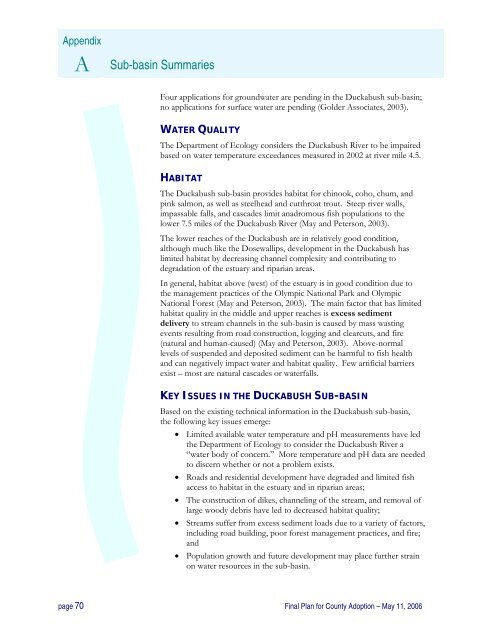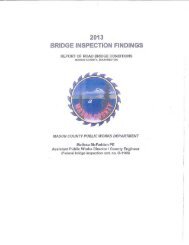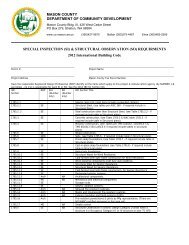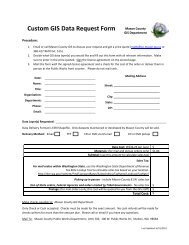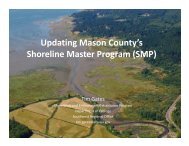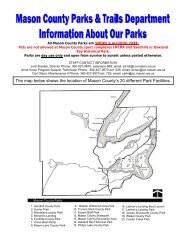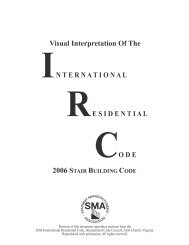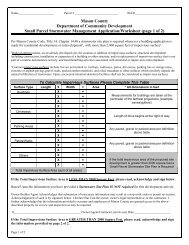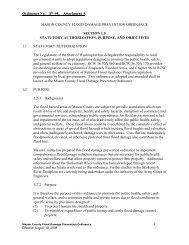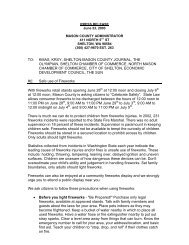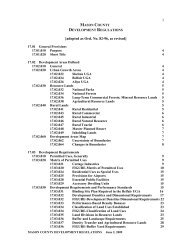Watershed Management Plan - Mason County
Watershed Management Plan - Mason County
Watershed Management Plan - Mason County
You also want an ePaper? Increase the reach of your titles
YUMPU automatically turns print PDFs into web optimized ePapers that Google loves.
Appendix<br />
A Sub-basin Summaries<br />
Four applications for groundwater are pending in the Duckabush sub-basin;<br />
no applications for surface water are pending (Golder Associates, 2003).<br />
WATER QUALITY<br />
The Department of Ecology considers the Duckabush River to be impaired<br />
based on water temperature exceedances measured in 2002 at river mile 4.5.<br />
HABITAT<br />
The Duckabush sub-basin provides habitat for chinook, coho, chum, and<br />
pink salmon, as well as steelhead and cutthroat trout. Steep river walls,<br />
impassable falls, and cascades limit anadromous fish populations to the<br />
lower 7.5 miles of the Duckabush River (May and Peterson, 2003).<br />
The lower reaches of the Duckabush are in relatively good condition,<br />
although much like the Dosewallips, development in the Duckabush has<br />
limited habitat by decreasing channel complexity and contributing to<br />
degradation of the estuary and riparian areas.<br />
In general, habitat above (west) of the estuary is in good condition due to<br />
the management practices of the Olympic National Park and Olympic<br />
National Forest (May and Peterson, 2003). The main factor that has limited<br />
habitat quality in the middle and upper reaches is excess sediment<br />
delivery to stream channels in the sub-basin is caused by mass wasting<br />
events resulting from road construction, logging and clearcuts, and fire<br />
(natural and human-caused) (May and Peterson, 2003). Above-normal<br />
levels of suspended and deposited sediment can be harmful to fish health<br />
and can negatively impact water and habitat quality. Few artificial barriers<br />
exist – most are natural cascades or waterfalls.<br />
KEY ISSUES IN THE DUCKABUSH SUB-BASIN<br />
Based on the existing technical information in the Duckabush sub-basin,<br />
the following key issues emerge:<br />
• Limited available water temperature and pH measurements have led<br />
the Department of Ecology to consider the Duckabush River a<br />
“water body of concern.” More temperature and pH data are needed<br />
to discern whether or not a problem exists.<br />
• Roads and residential development have degraded and limited fish<br />
access to habitat in the estuary and in riparian areas;<br />
• The construction of dikes, channeling of the stream, and removal of<br />
large woody debris have led to decreased habitat quality;<br />
• Streams suffer from excess sediment loads due to a variety of factors,<br />
including road building, poor forest management practices, and fire;<br />
and<br />
• Population growth and future development may place further strain<br />
on water resources in the sub-basin.<br />
page 70 Final <strong>Plan</strong> for <strong>County</strong> Adoption – May 11, 2006


